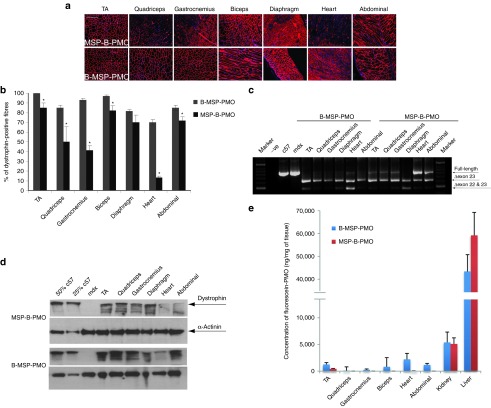Figure 2.
Correlation between the exon-skipping efficacy and tissue distribution for fluorescence-labeled B-MSP-PMO and MSP-B-PMO. Dystrophin expression and quantification of cellular uptake in body-wide muscles following systemic intravenous administration of fluorescence-labeled B-MSP-PMO and MSP-B-PMO at 25 mg/kg dose. (a) Immunostaining of muscle tissue cross-sections to detect dystrophin protein expression and localization in fluorescence-labeled MSP-B-PMO treated (top panel) and B-MSP-PMO treated mdx mice (bottom panel). Muscle tissues analyzed were from tibialis anterior (TA), gastrocnemius, quadriceps, biceps, diaphragm, heart, and abdominal wall (abdominal) muscles (scale bar: 200 μm). (b) Quantification of dystrophin-positive fibers in muscle cross-sections from mdx mice treated with 25 mg/kg fluorescence-labeled MSP-B-PMO and B-MSP-PMO. The data is presented as mean ± SEM and significant difference was detected in labeled B-MSP-PMO samples compared with MSP-B-PMO (t-test, *P < 0.05; n = 4, n represents the number of biological replicates). (c) RT-PCR to detect exon-skipping efficiency at the RNA level. Exon-skipping products are shown by shorter exon-skipped bands (indicated by Δexon23 – exon 23 deleted; Δexon22&23 – both exon 22 and 23 skipped). (d) Western blot for dystrophin expression in MSP-B-PMO and B-MSP-PMO treated mdx mice. Equal loading of 10-µg protein is shown for each sample except for the C57BL/6 control lanes where 5 and 2.5 µg protein was loaded. (e) Tissue distribution data fluorescence for fluorescence-labeled B-MSP-PMO and MSP-B-PMO in body-wide muscles following single systemic intravenous injection of 25 mg/kg florescence-labeled compounds. Substantially increased uptake in muscle groups treated with B-MSP-PMO compared with corresponding tissues treated with MSP-B-PMO was observed (t-test, *P < 0.05; n = 4, n represents the number of biological replicates). MSP, muscle-targeting peptide; PMO, phosphorodiamidate oligomers.

